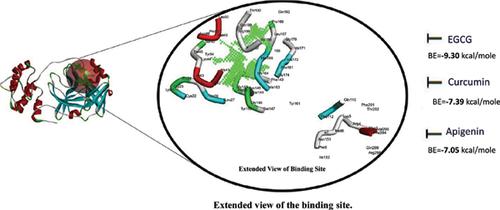Letters in Drug Design & Discovery ( IF 1.2 ) Pub Date : 2021-05-31 , DOI: 10.2174/1570180817999201209204153 Mohammad Faheem Khan 1 , Mohsin Ali Khan 1 , Zaw Ali Khan 1 , Tanveer Ahamad 1 , Waseem Ahmad Ansari 1

|
Background: Recently, Coronavirus Disease-2019 (COVID-19), caused by a fatal strain of coronavirus named Severe Acute Respiratory Syndrome-2 (SARS-CoV-2), has been declared as a pandemic by the World Health Organisation (WHO) on 11 March 2020. Globally, no therapy such as vaccines and specific therapeutic agents is available so far despite some protease inhibitors and antiviral agents.
Introduction: Due to no therapeutic drug or vaccine against SARS-CoV-2 so far, phytomedicine may be developed as therapeutic agents in the prevention and treatment of current COVID-19 disease. Thus, the aim of this study was to find out a suitable therapeutic agent from selected 17 dietary molecules, which could target SARS-CoV-2 encoded proteins.
Materials and Methods: In this study, 3D structures of selected dietary molecules were obtained from the PubChem database, which have previously been reported for their antiviral and anti-inflammatory effects. Then, molecular docking analysis by using AutoDoc4 and AutoDockVina software was conducted to evaluate their anti-SARS-CoV-2 activity. Lipinski’s rule of five and drug-likeness properties were also discussed with the help of Molinspiration and the OSIRIS property explorer methods.
Results: Our results revealed that, among all, epigallocatechin gallate (EGCG) (7) is a lead compound that could fit well into the binding sites of docked proteins of SARS-CoV-2. EGCG showed very strong molecular interactions with the free enzyme of main protease (6y2e), chimeric receptorbinding domain complexed with human ACE2 (6vw1), and NSP15 endoribonuclease (6vww) encoded proteins of SARS-CoV-2, by showing binding energies -9.30, -8.66, and -8.38, kcal/mole, respectively.
Conclusion: In the present study, EGCG (7) is more active than two standard drugs that are currently being used in COVID 19, namely remdesivir and nafamostat. Therefore, EGCG (7), as per our results, might be explored as a therapeutic agent for the treatment of COVID-19.
中文翻译:

将膳食分子鉴定为潜在 SARS-CoV-2 病原体的计算机模拟研究
背景:最近,由一种名为严重急性呼吸系统综合症 (SARS-CoV-2) 的致命冠状病毒株引起的 2019 冠状病毒病 (COVID-19) 已被世界卫生组织 (WHO) 宣布为大流行病2020 年 3 月 11 日。在全球范围内,尽管有一些蛋白酶抑制剂和抗病毒剂,但迄今为止还没有可用的疗法,例如疫苗和特定的治疗剂。
简介:由于目前还没有针对 SARS-CoV-2 的治疗药物或疫苗,植物药可能被开发为预防和治疗当前 COVID-19 疾病的治疗剂。因此,本研究的目的是从选定的 17 种膳食分子中找出一种合适的治疗剂,其可以靶向 SARS-CoV-2 编码的蛋白质。
材料和方法:在这项研究中,选定的膳食分子的 3D 结构是从 PubChem 数据库中获得的,之前已经报道了它们的抗病毒和抗炎作用。然后,使用 AutoDoc4 和 AutoDockVina 软件进行分子对接分析,以评估其抗 SARS-CoV-2 活性。在 Molinspiration 和 OSIRIS 属性浏览器方法的帮助下,还讨论了 Lipinski 的五法则和药物相似性属性。
结果:我们的结果显示,其中,表没食子儿茶素没食子酸酯 (EGCG) (7) 是一种先导化合物,可以很好地融入 SARS-CoV-2 对接蛋白的结合位点。EGCG 与主要蛋白酶 (6y2e) 的游离酶、与人 ACE2 复合的嵌合受体结合域 (6vw1) 和 NSP15 内切核糖核酸酶 (6vww) 编码的 SARS-CoV-2 蛋白显示出非常强的分子相互作用,通过显示结合能 -9.30,分别为 -8.66 和 -8.38 千卡/摩尔。
结论:在本研究中,EGCG (7) 比目前用于 COVID 19 的两种标准药物,即瑞德西韦和那法莫司他更有效。因此,根据我们的结果,EGCG (7) 可能被探索为治疗 COVID-19 的治疗剂。









































 京公网安备 11010802027423号
京公网安备 11010802027423号